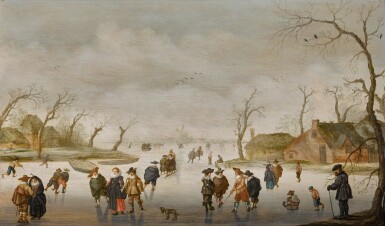Old Masters Evening Auction
Old Masters Evening Auction

The Property of a European Private Collector
Anthonie Verstraelen
Winter landscape with elegant figures playing kolf and skating on a frozen river
Auction Closed
July 6, 06:35 PM GMT
Estimate
80,000 - 120,000 GBP
Lot Details
Description
The Property of a European Private Collector
Anthonie Verstraelen
Gorinchem 1594 - 1641 Amsterdam
Winter landscape with elegant figures playing kolf and skating on a frozen river
oil on oak panel
24 x 40.2 cm.; 9½ x 15⅞ in.
---------------------------------------------------
歐洲私人收藏
安東尼・韋斯特拉倫
1594年生於霍林赫姆,1641年卒於阿姆斯特丹
《冬日景致:在結冰河面上玩考爾夫球及溜冰的優雅男女》
油彩橡木畫板
24 x 40.2 公分;9½ x 15⅞ 英寸
Consul Ivar Hellberg, Stockholm, by 1938;
With P. de Boer, Amsterdam;
With David Koetser, Zurich, from whom acquired.
Anthonie Verstraelen was among the first artists to specialise in the winter landscape as an independent genre. Verstraelen was most heavily influenced, along with his contemporary Arent Arentsz. Van der Cabel (circa 1585–1631), by the greatest early proponent of the subject, Hendrick Avercamp (1585–1634) – this is apparent here in the rather sparsely placed figures and low horizon line. Avercamp carried out his apprenticeship in Amsterdam, but thereafter appears to have settled permanently in Kampen; Van der Cabel and Verstraelen, however, both Amsterdam-based artists, must have been exposed to his work, and subsequently propagated Avercamp’s approach to this most quintessential of Dutch genres – perhaps indicating that Avercamp returned to Amsterdam at some later stage.
Verstraelen appears only ever to have painted ice scenes, with figures engaged in all the activities and games – such as kolf – associated with the frozen waterways, which became a familiar feature of the first decades of the seventeenth century, during the so-called ‘Little Ice Age’, when a series of harsh winters resulted in lengthy frosts. Skating not only served as a diversion during this time, but also a practical means of transportation, along with sleds, ice yachts, and prikslees – the small push sleds propelled by sticks that the boy on the right is using here.
The figures in this scene – more elegant and of higher quality than others sometimes found in Verstraelen's paintings – are on the whole richly-dressed, reflecting the height of early 17th-century fashion – the men’s breeches are tied with ribbon at the knees; the lady just left of centre is wearing a black vlieger (the long garment worn over the bodice and skirt); and the lady on the left is wearing a Brabant huik (a headdress consisting of a flat round with an upstanding spike, and a floor-length black veil).
The framing device of the tree on the right of this composition is typical of Verstraelen’s works, as are the two horizontal banks with houses and more trees, set at slight intervals to aid in the recession of the design, which is set out in Verstraelen’s characteristic style, with figures populating the foreground and a frozen waterway stretching through the village into the distance. The icy, monochrome tones of the sky and middle-ground are somewhat offset by the shadows the figures cast on the slightly warmer foreground, suggestive of faint sunlight.
